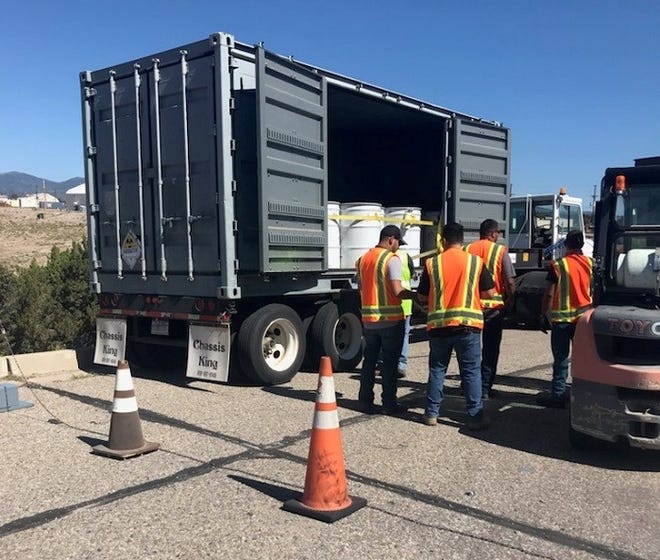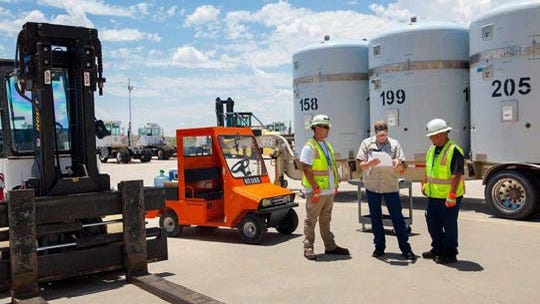Mitigating the spread of COVID-19 meant slowing shipments of nuclear waste to the Waste Isolation Pilot Plant repository near Carlsbad, as staffing was lowered to avoid infections of the virus.
At the peak of the health crisis last winter, shipments declined to five a week – about half of the pre-pandemic shipment rate of about 10 per week.
As vaccines became increasingly available this summer and infection numbers dropped, shipments of the waste were increased to as high as 12 a week last month while the facility’s goal is to average 10.
More:Feds see no problems with nuclear waste storage in West Texas, New Mexico despite concerns
In two years, shipments were hoped to increase to 17 per week, per a news release from the U.S. Department of Energy.
On July 22, the DOE reported WIPP received shipments from four different sites in one day for the first time since 2013.
The waste that day came from Los Alamos (LANL), Idaho and Oakridge national laboratories and from the Savannah River Site in South Carolina.
More:Waste Isolation Pilot Plant needs more space to dispose of nuclear waste, officials say
Since WIPP first opened in 1999, it received 12,942 shipments as of July 21, records show.
In 2019, the facility received 292 shipments, dropping to 192 last year due to COVID-19 restrictions.
WIPP received 179 shipments so far in Fiscal Year 2021, running from Oct 1 to Sept. 30.
Los Alamos recently announced it completed its 30th shipment of the fiscal year to WIPP.
More:New Mexico lawmakers warned of dangers of nuclear waste facility proposed near Carlsbad

The laboratory began combining TRU waste shipments to increase efficiency, per a news release.
This allowed LANL to increase the amount of waste sent for disposal by combining older legacy waste with newly generated waste, the release read, with the site completing its first comingled shipment in January.
Ellen Gammon, waste and engineering manager at contractor N3B at LANL said the new method was intended to move more nuclear waste out of Los Alamos to improve safety at the facility.
More:Nuke waste from Cold War coming to Waste Isolation Pilot Plant from Idaho National Laboratory
“We are excited with the progress our team has made to move waste out of Los Alamos,” Gammon said. “Making the thirtieth shipment this fiscal year demonstrates the strong progress we have made toward cleaning up legacy waste at Los Alamos.”
The waste, known as transuranic (TRU) waste consisting of clothing materials and equipment irradiated during nuclear activities, is emplaced in an underground salt deposit at the facility where the salt rock gradually collapses to entomb the waste.
Drums of TRU was are brought to the site by truck in two-person teams, stopping for safety inspections, meals and gas along the way.
More:New Mexico leaders oppose Holtec International nuclear waste site proposed near Carlsbad
As of June 30, WIPP reported its drivers had traversed about 15.5 million miles.
The shipments are tracked via satellite and have designated parking spots along the routes to ensure their safety, the release read.
State and Tribal officials are notified by the DOE two hours before a WIPP shipment enters their state or territory.
More:WIPP: Lawmakers briefed on plans to up nuclear waste shipments to facility near Carlsbad
Mark Bollinger, deputy manager of the DOE’s Carlsbad Field Office which oversees WIPP said the recent resurgence of COVID-19’s Delta Variant was a concern.
Case of COVID-19 recently spiked in Eddy and Lea counties in the southeast region of New Mexico where WIPP is located.
On Wednesday, Eddy County reported 40 new cases of the virus – the second-highest in the state – with 25 reported in Lea County.
More:8th panel for nuclear waste disposal at Waste Isolation Pilot Plant will be ready in 6 months
“As EM sites continue to make substantial progress in their cleanup missions, WIPP looks forward to continuing to safely accept these shipments and properly dispose of the waste,” he said.
Idaho National Laboratory continued to lead in shipments to WIPP as of July 31, per the latest data from the facility, with 6,583 and 9.2 million loaded miles.
The former Rocky Flats Environmental Technology Site in Denver was second with 2,045 shipments on 1.4 loaded transport miles followed by LANL in northern New Mexico at 1,471 shipments but just 503,082 miles.
Last month, a total of 24 shipments were received with 26 brought in in June.
May had 20 shipments with 27 in April.
Adrian Hedden can be reached at 575-618-7631, achedden@currentargus.com or @AdrianHedden on Twitter.








